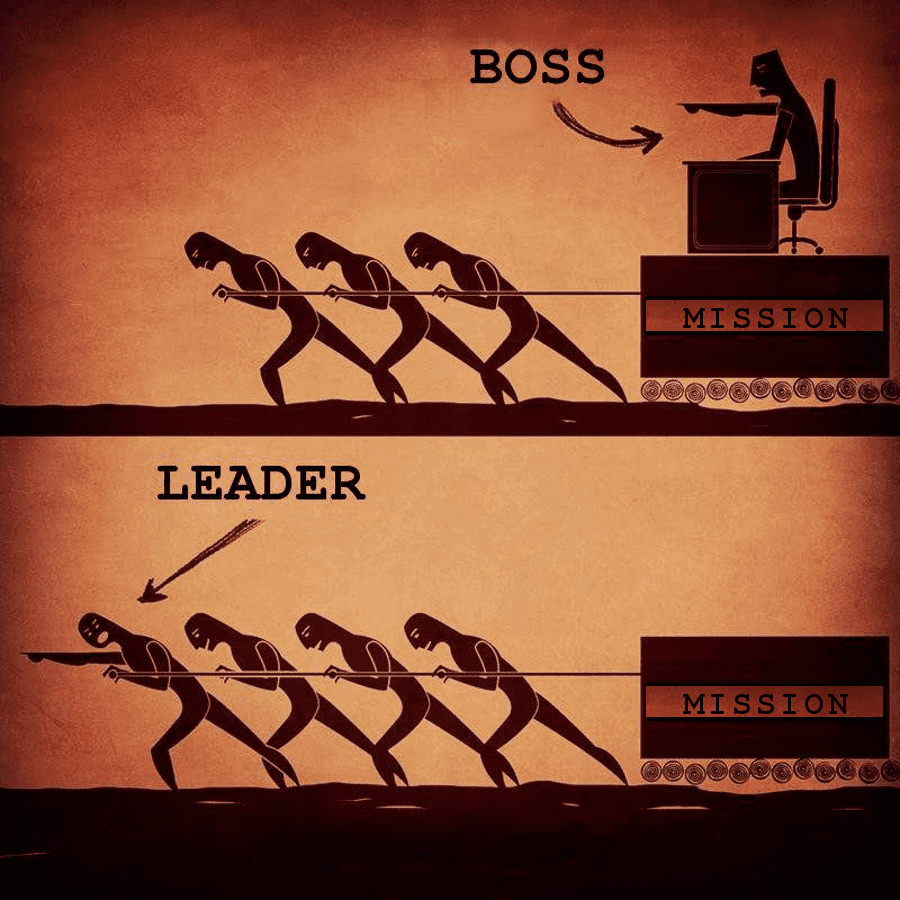What's the difference between a good leader vs. bad leader? What do good leaders do differently?
It's an essential question every leader must ask themselves.
We all face challenges and situations every day that test our patience, skills, and mindset. Unfortunately, there is no magical, drama-free team. What separates a good leader vs. bad leader is how they handle the challenges they face every day.
Today, we take a look at 6 leadership scenarios that we all commonly face regularly, and that are handled very differently by leaders depending on their good or bad approaches. You'll see what the consequences are of those decisions and what path to take instead.

6 Leadership Scenarios that Separate a Good leader vs. Bad leader
We previously wrote a post looking at how a positive outlook can make a huge difference in your daily happiness and how you lead. Leaders told us they loved our good vs. bad storytelling approach, so we're bringing it back to highlight the differences in a good leader vs. bad leader again today.
Here's the leadership scenarios we're covering:
- 1) Handling an employee's idea
- 2) Taking questions from your team
- 3) Managing the unknown
- 4) Working with different personalities and cultures
- 5) Rolling up your sleeves
- 6) Promoting people on your team

1) Good leader vs Bad leader: An employee's idea
The situation: An employee comes to you with a suggestion to help the team. As their leader, it's something you probably already should have done, but haven't gotten around to.
- Example of bad leadership: You feel a bit bothered when they try to tell you what to do. While they probably didn't mean anything by it, you find it annoying. You either ignore their suggestions completely, come up with reasons why you can't follow their advice, or criticize them.
- The Result: Your team member will learn making suggestions isn't worth the effort. Much will go unsaid, good ideas will lay dormant, and your team is likely to complain about you behind your back.
Or you could go another way...
- Example of good leadership: It's never fun to face harsh truths, but you embrace it. You recognize that your team needs to feel comfortable bringing concerns and ideas to you, so you thank them for the feedback. You also ask a few questions to be sure you understand their suggestion fully.
- The Result: Your team member feels heard, and you gain a new understanding of why you may want to bump an issue or opportunity up your priority list.
Feedback from your team is the lifeblood of good management; they see so much you don't get the chance to give all your responsibilities. If you've made a few mistakes and need to work on your team being more comfortable giving you feedback, this post can help you get more team feedback.

2) Good leader vs. Bad leader: Questions from your team
The situation: An employee in a long meeting asks a tough question: they zoom out and question the value of the project you're all focused on. "How did we get here? What made us decide to do this in the first place?"
- Example of bad leadership: Shocked and offended, you think to yourself, "How dare they question my decision??" You glare at the team member and change the subject to focus back on the original discussion.
- The Result: A chilling effect sweeps across your team. They know not to raise tough questions to you in meetings and just go along with things. Healthy debate is a phrase foreign to your team.
Or you could go another way...
- Example of good leadership: You take a deep breath and address the question head-on. Depending on the situation, you either explain the motivations for the decision they may not know for the benefit of the whole team, or you engage them Socratically to ask questions to them to reveal the reasoning. If the way they asked was disruptive, you talk to them about it in their next 1 on 1 or privately after the meeting.
- The Result: Your team sees that with you, there are no dumb questions, and it's safe to challenge the status quo. This helps your team explore new ideas fully, and avoid missing the forest for the trees.
It can be hard to manage people who have strong opinions and ideas, but they can also be your greatest asset. If you remember you're all on the same team and trying to win together, you can avoid feeling negative about their comments.
Best of all, if you work on your skill at asking questions, you can engage them and your whole team to more deeply understand where they're coming from and the best solution going forward. Learn more about the skill of curiosity and asking questions here.

3) Good leader vs. Bad leader: Managing the unknown
The situation: You have someone on your team in a role you've never done yourself. You're not familiar with all the nuance of what they do, nor their keys to success.
- Example of bad leadership: You feel a bit threatened by the hire, and some imposter syndrome, so you fake it. You pretend you know more than you do and go super hands-off with them. It's their job to tell you what you need to know, right?
- The Result: Communication quickly breaks down between you and the team member. They roll their eyes when you pretend you know what they're talking about. Your relationship becomes adversarial as they try to manage you out of the way so they can just get their work done.
Or you could go another way...
- Example of good leadership: Recognizing your knowledge gap, you take it head-on. You spend time with them to learn from them and ask questions when you don't understand something. Together, you come up with a plan you can hold them accountable to for the work you're less familiar with.
- The Result: You build more trust with them, and show that your team has a culture of humility for things they don't know. By having a plan, you can still tell how they're performing relative to expectations despite your relative newness to their field of work.
As important as developing the task relevant maturity of your team is, your task relevant maturity matters, too. Embracing the need to learn new skills and admit when you don't know is a growth mindset well worth demonstrating. Learn more how to level up your task relevant maturity here.

4) Good leader vs. Bad leader: Working with different personalities and cultures
The situation: Your company is dabbling in remote work, or recruiting from outside your region. You were raised in an area where everyone says things indirectly and gently, but your new hire is more direct. This video captures a somewhat humorous example of the difference:
In the workplace, it could then turn out this way:
- Example of bad leadership: Resentful of their communication style, you blame them for all communication issues. After all, you're the boss, so they should adapt to you. Using your preferred style, you drop subtle hints that they seem to be completely ignoring, much to your frustration.
- The Result: You both become increasingly frustrated with each other. You feel like they're abrasive, and they feel like they can't get a straight answer from you. It makes you both want to avoid the other, leading to poor teamwork.
Or you could go another way...
- Example of good leadership: Recognizing their difference in personality, you make an effort to better understand them. You try to be more explicit in your communication with them, and not wince too much when they're more direct than you're used to. You also coach them on how to get a point across with slightly smoother edges.
- The Result: While it's not easy, you work together to reach an understanding of how you each communicate. Finding some common ground leads to better results, and open communication keeps ideas flowing between you both.
Any time there's a problem on your team, it's important to start by looking in the mirror. There's always something you were doing (or not doing) to contribute to the issue.
A healthy dose of self-awareness can help you start from a perspective of how you can do your part to improve difficult situations. Best of all, when you lead the way taking problems head on, you make it easier for your team members to admit faults and do their part as well. Learn how to improve your self awareness here.

5) Good leader vs. Bad leader: Rolling up your sleeves
The situation: You get a coach to help you be a better leader. The coach tells you passionately you must do something you've never gotten around to.
- Example of bad leadership: You shrug off the advice thinking, "It's extra work, and I'm sure it can wait. I don't see them for a month anyways." You let your mind run and rationalize away why the advice doesn't apply or isn't as important as the 38 other things on your to-do list.
- The Result: You miss out on the impact your coach knew the effort could have. Compounding the issue, when they see you haven't made the change, they start to lose faith in your willingness to listen. Soon, they're less interested in coaching you, or avoid certain topics that could help but seem to fall on deaf ears.
Or you could go another way...
- Example of good leadership: You recognize that you picked this coach for their experience and insights. If they're passionate about doing this now, it must be important. It's not easy making time, but you find ways to carve out enough to get it done.
- The Result: You complete the effort and you see how it starts to impact your team in ways you never expected. Your coach also becomes more confident in working with you seeing that it's a good investment of their time. They continue to challenge and push you to become better because of it.
There's never enough hours in the day to do everything we want to do. That's why it's so important to manage your schedule well so you don't fill it only with low-value tasks. Whether you choose to eat the frog first thing in the morning, or use the pebbles, sand, and water analogy to budget your time, making sure to get important things done is critical to your success as a leader.
Sometimes that can be especially hard because there's so many fires. This post can help you get out of that reactive management mode if you're in deep.

6) Good Leader vs. Bad Leader: Promoting people on your team
The situation: You’re deciding who on your team is the best candidate for a promotion. Who you choose will change your team dynamics from current roles to what gets back filled, what you signal you’re rewarding, to who you’ll work more closely with going forward.
- Example of bad leadership: You promote a team member based on their success in their current role. They’ve proven themselves before, so you assume they’ll do a great job. However, the new role is quite different from what they were doing up until now.
- The result: Unfortunately, doing well at one job doesn’t mean they’ll thrive in another one, nor have the skills and interest to succeed. Too often, leaders and the team members they hire and promote fail to think about how a new role may be different from what they’re doing today.
Not only may they lack the necessary skills, but it’s no certainty they’ll enjoy the work either if you haven’t talked about it in detail with them. All of this combines for a recipe for disaster: failed promotion, disappointed colleagues, and a questioning of your judgment as a manager.
Or you could go another way...
- Example of good leadership: Instead of promoting people based on their success in their current role, a good manager considers the skills they’ll need in the new job. For example, if you want to promote a person from a blog writer to a manager, you wouldn’t consider their writing skills. You’d consider if they have great leadership qualities including:
1. Having empathy for others and an interest in helping with "people problems."
2. Being a good listener, so they can ask good questions and have empathy for their team.
3. Showing consistency, as well as being detail oriented and accountable in their work, so they set a good example to their team.
4. Have a growth mindset, so they continue learning new skills they need for the role.
5. Show interest in being a manager, so that you're sure they want the responsibilities that come with being a leader.
- The result: If you take time to think about the skills people need to succeed in a role, and clearly communicate them to people before promoting them, you'll have an easier time giving them roles where they can succeed. You'll also avoid someone taking a job for the wrong reasons.
Regardless of who you promote, it's important to view it as an ongoing commitment and decision. You need to talk to potential promotion candidates before they take the role, to make sure they have the skills and interest. Then, you also need to support them afterwards to make sure they have a smooth transition and the guidance they need to continue growing afterwards.
If you need to tune up your coaching, or are thinking about how to develop leaders on your team, start with these posts:
- Employee Coaching: Why it Matters and How to Become Great at It
- Developing Leaders: 6 Keys to Identify & Develop New Leaders
- Learn to avoid the Common Mistakes Companies make when Promoting from Within

Common Questions for New Leaders
If you’ve made some mistakes from the “bad leader” examples, how can you rebuild trust with your team?
It’s never easy to admit you were wrong, but it’s a critical first step. The key is to own the mistakes you made rather than make excuses.
Lean into the issue by gathering everyone involved and sincerely apologize for your actions and the impact it had. Most importantly, make it clear what actions you’ll take to avoid repeating those behaviors going forward.
Over time, you’ll have to work to regain their trust. Your one-on-one meetings are a great time to have a judgment-free conversation listen to any of their lingering frustrations and get additional feedback.
Remember to practice active listening skills to ensure you understand their perspective, and then follow through on any promises you make; doing what you say you’ll do is foundational to rebuilding trust and being a good leader.
What are some early warning signs that you may be slipping into some of the “bad leader” behaviors without realizing it?
Catching yourself early is key to preventing small issues from growing into larger trust problems. So here are some bad habits to avoid:
- You stop proactively giving praise or recognition to your team members for good work.
- You get annoyed or defensive when employees bring ideas or concerns to you.
- You find yourself criticizing people rather than coaching them through issues.
- Team members seem to avoid bringing up certain topics with you.
- You don’t ask questions in team conversations, instead defaulting to stating your opinions.
- You feel overwhelmed and fail to delegate tasks that could be handed off.
- You get frustrated with managing different personalities and communication styles
What is bad leadership behavior?
Bad leaders can slowly damage your culture and turn a great workplace toxic. Fortunately, spotting unhealthy leadership habits early allows you to course-correct or limit the harm. Here are some warning signs to watch for:
- Does the leader lack self-awareness about their behaviors? For example, do they fail to take responsibility when mistakes happen and are quick to blame external factors or other people?
- Do they lack empathy, warmth, and focus when interacting with direct reports? Do they see managing people as something annoying and a waste of time?
- Are they inconsistent in their actions? Do they fail to follow through on promises or enforce rules haphazardly across the team?
- Does the team seem afraid to share concerns, new ideas or important company information with them? Keeping people in the dark can be very frustrating.
- Do they take credit for wins but defect blame on losses? Everyone notices a lack of integrity, and stealing credit can especially bother your top performers.
If you see any managers doing even a few of these things, you know you have a bad leader in your organization.
We’ve barely scratched the surface here on what to do about bad leaders. For more expert advice on addressing unhealthy management behaviors, check out these additional posts:
- Bad Leadership: 5 Ways To Recognize Bad Managers At Your Company
- How To Stop Being A Bad Leader And Turn Around A Miserable Team
- 5 Signs Of A Bad Manager Senior Leaders Should Look For Before It's Too Late

There's a fine line between good and bad leadership - use these bad leadership examples to avoid common mistakes
The difference between a good leader vs. bad leader is often subtle. It's all in your mindset and your ability to take ownership of problems and opportunities in a positive way.
| Scenario | Bad Leadership Example | Good Leadership Example |
|---|---|---|
| Handling an employee's idea | Ignore or criticize the idea and your employee | Thank your employee for the feedback and ask questions to understand their suggestion |
| Taking questions from your team | Get offended, change the subject, and make your team afraid to ask questions | Address the question head-on, explain your reasoning, or discuss privately later |
| Managing the unknown | Pretend you know, ignore uncertainty, and leave your team to sink or swim alone | Spend time learning from the expert, ask questions, and make a plan to work together |
| Working with different personalities and cultures | Blame others for communication issues and avoid them | Make an effort to understand differences and find common ground |
| Rolling up your sleeves | Shrug off advice and keep putting off taking action | Recognize the importance and prioritize taking action, even if it’s uncomfortable |
| Promoting people on your team | Promote based on success in their current role or your personal feelings only | Consider skills needed for the new role, ensure interest alignment, and support their transition |
In all the situations above you can see how the same helpful people all around a manager can be met with either resistance or gratitude.
The good leader sees the glass half full and everyone wants to help them. Meanwhile, the bad leader is stressed out and can't figure out why everything is always so frustrating and trying to give them more work.
It's easy to read these and say, "I'll be the good leader, of course." However, it's harder in the moment.
You need to have a growth mindset, manage external pressure, and fight any imposter syndrome that has crept into your psyche.
You can check out this episode of the "High Performing Teams" podcast to learn more about essential do's and don't's for managers including different ways to give and receive feedback, and get buy-in:
No one is a natural at all of this, so stay positive even when you slip. Teams respect leaders who admit when they're wrong and put in the work to make things right. The payoff is well worth your investment: loyalty, hard work, and seeing the best work from your team.





